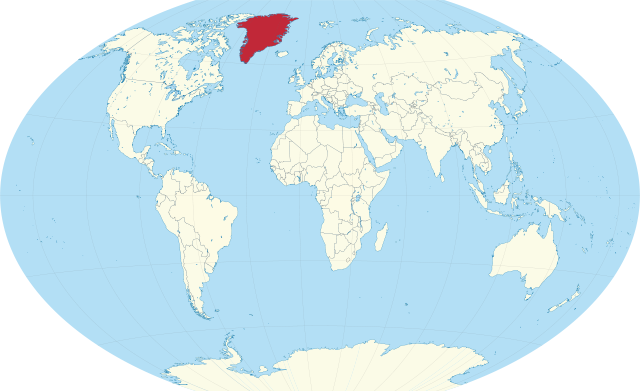Greenland’s first official mention dates from 1053, as Pope Leo IX decided to commend the territory to Bishop Adalbert1. Its territory (2.1 km2) is equivalent to the size of New Guinea, Borneo and Madagascar reunited2, thus being the world’s largest island3. It is also the second-largest ice sheet4. The population is estimated at 56,000 inhabitants, mainly Inuit. The capital is Nuuk, with 17,600 inhabitants5. Internal and external transportation takes place by sea or air, as the country does not have a road system6.
It is strategically located in the Arctic (500 miles from the North Pole) and the North American continent, between North America, Russia and Europe7. Thus, the island was an Allied bastion during World War II and during the Cold War8.
Its international significance9 is growing in the global fight against climate change, the increasing recognition of the rights of indigenous peoples, and the exploitation of natural resources. As for those10, the region is notorious for its fisheries sector. Moreover, it gathers 10% of global freshwater. Greenland ranks as the 3rd world’s reserve in uranium, being also a potential key supplier for rare-earth metals.
These elements are so important for Greenland that controversy about mining rights created a political crisis in 2021. In December, the former Siumut government had presented the Kuannersuit Mineral project for thorium, uranium, and rare-earth elements mining11. Inuit opposition party threatened to boycott its application while the democrat party left the government, thus leading to the dissolution of the Parliament and to extraordinary polls in April 2021. The electoral process that followed was labelled as “Greenland’s Rare-Earth Election”12 by the international press; it produced a major political shift and voting saw a higher turnover than usual.
As Head of State, Denmark’s Queen, Margrethe II, and her government also rule over Greenland, where a High Commissioner represents them13. The Danish Parliament keeps two seats for Greenlandic members, occupied by the two largest parties in Greenland. Denmark is also Greenland’s principal supplier and trade partner14.
After a referendum in 2008, Greenland’s Home-Rule Act of 1979 was transformed into the more comprehensive Self-Rule, a legislation that allows for a large autonomy, despite the Executive role of the High Commissioner. Elected every four years, Greenland’s parliament counts on 31 members that work in 13 committees15. It chooses a Prime Minister, known as the Premier. The island has its government, the Naalakkersuisut, appointed by the Premier and composed, on average, of 10 members.
The territory displays several sovereignty symbols such as its hymn, flag, and post office16, and four representation missions abroad. Additionally, revenue from mineral resources belongs to Greenlandic authorities17. The island left the European Economic Community in 1985. In 2003, the Itilleq Declaration defined the possibilities for Greenland to act at the international level. Nowaday, Greenland’s foreign policy is based on the Danish Constitution, the Self-Rule Act, and custom practices18.
The Self-Rule Act also opens19 the door20 for a negotiated secession21 based on a: “explicit statement that the people of Greenland will decide on Greenland independence.”22Established already in 2017, a Constitutional Commission23 is currently discussing the possibilities for its political future, including free association with a third country.24
This paper will present the legal framework and Greenland’s steps towards more autonomy since the Cold War. After, it shall examine the island’s relationship with key countries such as the United States. The third part of this text will describe the regional position of Greenland in the Arctic, while the last will analyse its particular ties with the European Union. The conclusions will underline key features of Greenland’s paradiplomacy (…)
You will could dowland the complete publication in february, when “Paradiplomacy in Europe…” release
1 Tomala, M. (2017). The European Union’s Relations with Greenland. International Studies. Interdisciplinary Political and Cultural Journal, 20(1), 31–46. https://doi.org/10.1515/ipcj-2017-0015
2 Zellen, B. (2021). High Stakes in the High North: Alternative Models for Greenland’s Ongoing Constitutional and Political Transformation. Nordicum-Mediterraneum. Seen on December 2021, at https://nome.unak.is/wordpress/volume-16-no-2-2021/new-double-blind-peer-reviewed-article-volume-16-no-2-2021/high-stakes-in-the-high-north-alternative-models-for-greenlands-ongoing-constitutional-and-political-transformation/
3 Escach, N. (2019) « Nuuk : un modèle groenlandais de métropole arctique ? », Nordiques [En ligne], 37 | 2019, seen on December 7th 2021. URL: http://journals.openedition.org/nordiques/432 ; DOI : https://doi.org/10.4000/nordiques.432
4 Garcés De Los Fayos, F. (2014, May). Greenland: The challenge of managing a key geostrategic territory (DG EXPO/B/PolDep/Note/2014_16 PE 522.332). European Parliament. Directorate-General for External Policies Policy Department https://www.europarl.europa.eu/RegData/etudes/briefing_note/join/2014/522332/EXPO-AFET_SP(2014)522332_EN.pdf
5 Brańka, T. (2018). Greenland – from Autonomy to (In)Dependence. Przegląd Strategiczny, 11, 107–128. https://doi.org/10.14746/ps.2018.1.8
6 Denmark – Other Areas in the Kingdom of Denmark. (n.d.). International Trade Administration | Trade.Gov. Retrieved December 8, 2021, from https://www.trade.gov/country-commercial-guides/denmark-other-areas-kingdom-denmark
7 See above
8 Ackrén, M., & Jakobsen, U. (2014). Greenland as a self-governing sub-national territory in international relations: past, current and future perspectives. Polar Record, 51(4), 404–412. https://doi.org/10.1017/s003224741400028x p. 412
9 Brańka, op.cit, p.107
10 Escach, op.cit.
11 Meyer, op.cit.
12 See above
13 Garcés de los Fayos, op.cit., p. 6
14 Brańka, op.cit, p.120
15 Hofverberg, E. (2021, July 12). FALQs: Greenlandic Autonomy, Government Formation, and Mineral Resource Policy | In Custodia Legis: Law Librarians of Congress. Library of Congress Blog. Retrieved December 8, 2021, from https://blogs.loc.gov/law/2021/07/falqs-greenlandic-autonomy-government-formation-and-mineral-resource-policy/
16 Brańka, op.cit, p.109
17 Brańka, op.cit, p.121
18 The Legal Frameworks – Naalakkersuisut. (n.d.). The Government of Greenland (1). Retrieved December 8, 2021, from https://naalakkersuisut.gl//en/Naalakkersuisut/Departments/Udenrigsanliggende/Naalakkersuisuts-udenrigspolitiske-kompetencer/De-juridiske-rammer
19 Zellen, op.cit.;
20 Naalakkersuisut The Government of Greenland (2). Retrieved December 7th 2021, from https://naalakkersuisut.gl/en/About-government-of-greenland/About-Greenland/Politics-in-Greenland
21 Escach, op.cit.;
22 Brańka, op.cit, p.112
23 https://ina.gl/udvalg/lovpligtige-og-staaende-udvalg/forfatningskommissionen/?lang=en
24 Work on Greenland’s Constitution drafting restarts. (2020, May 21). Nationalia. Retrieved December 11, 2021, from https://www.nationalia.info/brief/11313/work-on-greenlands-constitution-drafting-resumes


